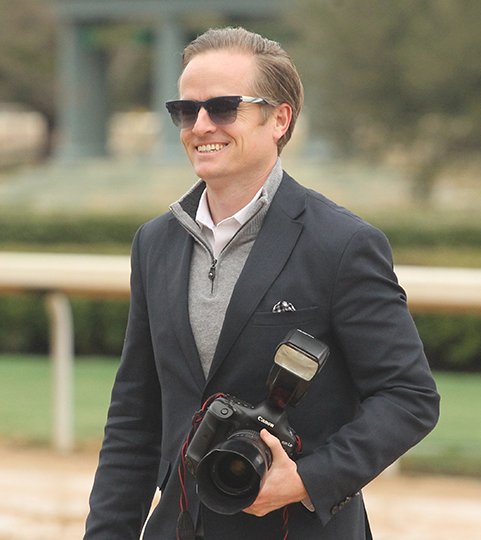EDITOR'S NOTE: It takes hundreds of workers each live race meet to ensure race days run smoothly. This is the next in a series of articles highlighting occupations surrounding the sport of thoroughbred racing, and how they work together to make each meet a success.
Coady Photography, one of the most widely contracted photography businesses among thoroughbred racetracks in the United States, got its unconventional start 55 years ago.
"We started in 1962, and originally my grandfather, when he was in Chicago the family business was funeral homes," Kurtis Coady, part owner of Coady Photography, said. "He couldn't take the cold weather anymore so he relocated to Arizona."
Because funeral licensing requirements vary from state to state, Coady's grandfather found work as a photographer for The Arizona Republic newspaper in Phoenix.
"One of the jobs they would always send him on was to Turf Paradise, which had just started as a racetrack," Coady said. "Turf didn't have a track photographer, he had the experience, and that's actually what started our career was him walking off the bus and getting a job at the newspaper."
Coady said his father and one of his uncles only worked in horse racing photography with his grandfather, and in the business' first few decades the photographers shot races in Canada, Arizona and Colorado.
As the years went on, Coady said more tracks contracted the business to photograph their races. After college, he said working for the family business was not in his plan.
"In high school I used to program, and this was back in 1996 -- nobody had ever gone digital in horse racing," he said. "My dad asked if I could write something to put together a process for how to go digital, and we could figure out the equipment. When we did it, we didn't think we would be able to create a better product at the time, but we ended up creating a better product and from there we went from about seven tracks to about 17 tracks almost overnight after we went digital."
With photographers spread out at tracks across the country, it's crucial all processes for taking and editing photos are consistent, Coady said. When those processes were developed, he said the bigger tracks took notice.
"Shortly after that, we started getting the big contracts," he said. "Oaklawn was actually what put us on the map. We got Oaklawn in 2003, about six years after we went digital, and pretty much from there we took off big time."
Coady was hired to the family business in 2007, though he already had his own business in racing, but unrelated to photography.
"When they hired me, we really cracked down on not looking like a mom and pop company and become more of a fixture in racing," he said. "In 2010, we ended up getting Keeneland which is easily one of the top six tracks in the world. From there on we started getting the bigger contracts and more contracts, and at that time we had 28 contracts.
"Two years ago -- which my dad and my grandfather have since passed and didn't get to see this -- but we're now the official photographer of the Kentucky Derby."
Track photography isn't just limited to the finish line and winner's circle. Typically, photographers are working seven days a week, Coady said, shooting morning workouts, getting photos of horses coming off planes and trailers, and anything else they can to help promote upcoming bigger stakes races.
On a typical stakes day, Coady said he has six photographers and that increases to 10 to 15 on a bigger race such as the Arkansas Derby. However, on the Kentucky Derby, he has anywhere from 30 to 40 photographers on hand.
On race days, fans can spot Coady by his suit and signature bow tie. During the business' rebranding several years ago, it was decided that all photographers on the team had to follow a set dress code, one Coady said honors the tradition of class that surrounded the sport for so long.
"Racing used to be about status," he said. "You wore your best outfit, your hats and it was the thing to do as an event. So our staff and my brothers -- we own the company together -- we make it a point to always be in suits, dress shoes and bow ties to help kind of push the class of racing. And it has helped. You see a lot more people really taking pride in the way they look coming to the races.
"In Kentucky, it's the norm, but at some of the smaller tracks we are trying to make it an event again."
Local on 02/23/2018
